1877
Charles Cros writes paper Apr. 18 describing how phonograph might be built, deposits it, sealed, with Academie des Sciences in Paris on Apr. 30. It is opened Dec. 5.
Thomas Edison makes notes of experiment in re cording sound with diaphragm and stylus July 18, sketches a recording system using a magnet and paper tape Aug. 12.
Cros's paper is discussed by the Abbe Lenoir in the Oct. issue of La Semaine du Clerge.
The phonograph is invented! Edison sketches the apparatus Nov. 29, and on Dec. 6 its construction is completed.
Edison gives public demonstration of phonograph Dec. 22 for Scientific American, two days later submits patent application describing both cylinder and disc formats, and both hill-and-dale and lateral recording processes.
1878
Edison granted patent on phonograph Feb. 19, incorporates Edison Speaking Phonograph Co. in Connecticut Apr. 24, patents magnetic recording process using steel sheet, then turns attention to development of incandescent light.
Emile Berliner goes to work for Alexander Graham Bell.
1879
James Ritty, an American, invents cash register.
1880
Bell sets up laboratory in Washington with Charles Tainter and Chichester Bell.
1881
The Bells and Tainter deposit a graphophone-using wax instead of Edison's tinfoil-with the Smithsonian Institution Oct. 20.
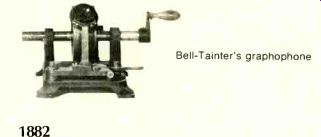
Bell-Tainter's graphophone
1882
Prof. Amos E. Dolbear awarded U.S. patent in Mar. for wireless communications equipment.
1883
Edison notes that current can be transferred be tween a filament and a plate sealed inside a glass bulb the idea behind the radio tube; applies for patent.
1884
Paul Nipkow granted German patent Jan. 6 for whirling disc scanning device, later used in television.
1885
Edison, on June 23, files his only patent for wireless communications, later bought by Marconi. C. Bell and Tainter apply for patent on graphophone, also on form of magnetic recording, June 27. American Telephone & Telegraph Co. formed.
1886
C. Bell and Tainter receive their patent for the graphophone May 4.
Edison resumes work on phonograph.
Heinrich Hertz starts research on radio waves.
First commercial AC generating equipment for electric lighting introduced, in Great Barrington, Mass.
1887
Wilhelm Hedic develops idea of putting magnetic particles on tape.
American Graphophone Co. formed in Washington in June.
Berliner applies Sept. 26 for patent on laterally re corded disc gramophone, patent issued Nov. 12.
Edison Phonograph Co. formed in Oct.
Berliner develops engraving and plating process for making records.
1888
Columbia Phonograph Co. organized in Feb. (incorporated Jan. 1889).
Edison introduces improved phonograph June 16.
Berliner gives first public demonstration of the gramophone same day.
North American Phonograph Co. formed July 14, by end of year becomes sole licensee for both phonograph and graphophone.
Oberlin Smith publishes article Sept. 8 describing magnetic recording.
1889
Brahms records cylinder in Vienna.
Edison releases first commercial recordings.
First nickelodeon, from Automatic Phonograph Co., placed in New York saloon Nov. 23.
1890
Gianni Bettini refines phonograph for quality reproduction.
1891
Josef Hofmann makes first "regular" ( Edison's word) piano recording at home in Berlin in Feb. or Mar.
Edison assumes control of North American Phono graph, sells first machines for $150 each.
Bettini begins selling cylinder recordings of famous opera singers.
1892
Nathan Stubblefield transmits human voice by wire less.
1893
Berliner forms U.S. Gramophone Co. in Washington.
Valdemar Poulsen graduates from University of Copenhagen, begins work on magnetic wire recorder.
At Columbian Exposition in Chicago, Edison demonstrates motion picture for the first time in public coupled to a phonograph cylinder, it is a sound movie.
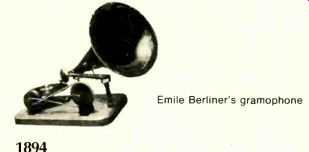
Emile Berliner's gramophone 1894
Francis Barraud paints His Master's Voice, featuring terrier and Edison phonograph.
Pathe Freres start making phonographs and cylinders in France.
In Aug., Edison throws North American Phonograph Co. into bankruptcy, and Columbia Graphophone builds first phonograph with spring motor, for $75.
1895
Guglielmo Marconi develops wireless in home tests in Italy.
Alexander Popov presents a paper on radio May 7, establishing Russian claim to its invention.
Berliner Gramophone Co. formed Oct. 8 with license from U.S. Gramophone Co.
18% Marconi files original wireless-telegraphy patent June 2 in England.
1897
Berliner switches from rubber to shellac and lime stone for record manufacture.
Marconi gets British patent on wireless July 2, forms Marconi Co. Ltd. American patent granted July 13.
1898
Berliner subsidiary, Gramophone Co., formed in London in May, opens branch in Germany (Deutsche Grammophon), which spawns sub-branches in Russia and Austria.
First paid radio message sent June 3 by Lord Kelvin from Isle of Wight for one shilling.
Poulsen receives Danish patent on his telegraphone, a magnetic recorder, in Dec.
1899
Francis Barraud sells His Master's Voice to Gramophone Co. after painting disc gramophone over Edison cylinder phonograph.
Adolphus Slaby forms Telefunken.
Marconi Wireless Telegraph Co. of America is incorporated Nov. 22.
1900
Emperor Franz Josef makes oldest extant magnetic recording for Poulsen at Paris Exposition.
Poulsen arrives in Washington in June to form American Telegraphone Co.
Emile Berliner registers His Master's Voice in July as trademark in U.S., manufactures gramophones.
Reginald Fessenden demonstrates radio voice trans mission Dec. 23.
1901
Fessenden begins work on continuous -wave transmissions.
First Red Label celebrity records appear, featuring Imperial Opera of Russia.
Victor Talking Machine Co. is formed Oct. 3 by Eldridge Johnson.
Marconi receives first transatlantic radio signal-the letter S-in Newfoundland Dec. 12.
1902
Cornelius D. Ehret files first patent ( U.S.) on FM broadcasting Feb. 10.
William Barry Owen and Fred Gaisberg make first Caruso records for the Gramophone Co. Mar. 18.
Victor, Columbia pool patents.
1903
President Theodore Roosevelt sends wireless message to King Edward VII from station in South Well -fleet, Mass., Jan. 9.
Victor opens Red Seal studio in Carnegie Hall, records first Red Seal disc Apr. 30.
Poulsen patents arc transmitter, involving modulation of frequency.
1904
Odeon in Berlin introduces two-sided records.
Lee de Forest demonstrates wireless at St. Louis World's Fair.
Columbia introduces two-sided discs in U.S. for $1.50 each in Aug.
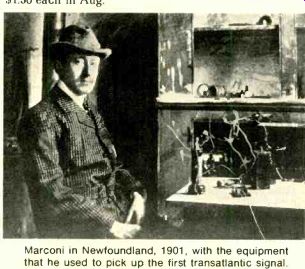
Marconi in Newfoundland, 1901, with the equipment that he used to pick up
the first transatlantic signal.
1905
Neophone in London introduces 20 -inch long-playing record.
De Forest invents audion three -element tube.
1906
Caruso and Scotti appear on first Red Seal duet disc in Mar.
Zonophone produces full-length Aida on 23 discs.
H. H. Dunwoody and G. W. Pickard invent cat's -whisker radio receiver.
Fessenden first broadcasts a phonograph record, Handel's Largo, Christmas Eve, also plays the violin.
1907
De Forest files for patent on audion tube, begins regular broadcasts in New York using Columbia records Jan. 29.
1908
American Telegraphone undergoes reorganization in May; Charles Dexter Rood named president.
Edison introduces Amberol cylinder in Oct.
1909
Odeon spends £800 to record Nutcracker Suite in Apr.; first large-scale orchestral work to be recorded in its entirety.
Charles Herrold starts Wednesday -evening series of record concerts on wireless station in San Jose, Calif.
Congress passes Copyright Act. Recordings not copyrightable.
1910
First broadcast from Metropolitan Opera Jan. 13 features Caruso and Destinn in Ca valleria rusticana and I Pagliacci.
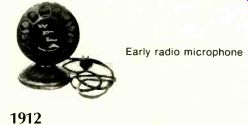
Early radio microphone
1912
De Forest borrows telegraphone for experiments in synchronizing sound with motion pictures.
Columbia makes last cylinders in July. Congress passes radio licensing law Aug. 13.
1913
Edison sponsors first live -vs. -recorded demonstrations, called "Edison Tone Test Recitals"; unveils hill-and-dale disc phonograph.
Odeon releases first complete symphonies ever re corded-Beethoven's Nos. 5 and 6.
Edwin H. Armstrong files patent for "feedback" circuit Oct. 29.
1914
General Electric begins manufacturing vacuum tubes.
Phonograph patents expire and new competitors appear: Sonora, Vocalion, Brunswick-Balke-Collender, others.
1915
Alma Gluck becomes first Red Seal artist to sell one million copies--of "Carry Me Back to Old Virginny."
First original-cast show recording, by English Columbia: Business as Usual.
Samuel Barnett's tiny Decca portable phonograph becomes popular with British troops in the trenches.
1917
Victor releases first Original Dixieland Jass [sic] Band recordings in May.
Leopold Stokowski and the Philadelphia Orchestra begin recording for Victor Oct. 22.
1918
Garrard Engineering Ltd. decides to make gramophone motors as peacetime product.
Armstrong invents superheterodyne radio circuit Dec. 30.
1919
Lionel Guest and H. 0. Merriman experiment with electrical recording in Britain.
Bell Telephone Laboratories begins work on electrical recording.
Radio Corporation of America formed from Marconi Co. of America Oct. 17.
Vladimir Zworykin conducts television experiments at Westinghouse.
1920
On Oct. 27, Department of Commerce authorizes KDKA, Pittsburgh, to operate on 360 meters-the first station to be so licensed in the U.S.; station begins regular schedule of broadcasts-one hour a day-in Nov. Guest and Merriman electrically record the burial service of the Unknown Soldier in Westminster Abbey, Nov. 11. English Columbia releases the record. Toscanini makes first Victor record Dec. 18.
1921
Max Kohl offers magnetic recorder with built-in tube amplifier for dictation, using steel discs.
First feature film to contain a song, D. W. Griffith's Dream Street, opens in New York May 1.
Mary Garden opens Chicago station KYW Nov. 11; it broadcasts nothing but the Chicago Civic Opera during its first season.
1922
Armstrong receives patent on super -regenerative circuit in July. AT&T station WEAF (now WNBC) takes to the air in New York Aug. 16, broadcasts first paid commercial Aug. 28. WGY, Schenectady, presents first U.S. radio drama, The Wolf, by Eugene Walter in Aug. At almost the same time, Marconi broadcasts Rostand's Cyrano de Bergerac in London. WIZ in Newark and WGY form first network radio hookup, for World Series beginning Oct. 27.
---------------
First broadcast by New York Philharmonic Sym phony Orchestra Nov. 22. Privately run British Broadcasting Co. (later Corp., when it becomes public in Jan. 1927) begins operations. Columbia sells British branch to Louis Sterling and associates in Dec.
By end of year, 569 radio stations licensed in the U.S., phonograph begins to decline.
1923
Victor leaves room in its consoles for customers to insert radios.
De Forest unveils film recording process. General Electric photographically records sound on tape. Western Electric tries to sync sound and film Apr. 2. Columbia goes into receivership in Oct. Vladimir Zworykin demonstrates electronic tele vision in Dec.
1924
Bell Telephone Laboratories builds prototype folded-horn speaker system. H. C. Harrison of Western Electric is granted patent for electrical recording in May. B. J. Grigsby begins making loudspeakers in U.S.; Celestion makes first component speaker in England.
1925
First commercial electrical recording session Feb. 25-by Art Gillham (The Whispering Pianist), for Columbia. In Mar., Victor licenses electrical recording process from Bell Laboratories. English Columbia buys American Columbia to obtain rights. First commercial electrical recording to be released, in Apr., is excerpt of University of Pennsylvania's Mask Wig Club, by Victor. Brunswick-Balke-Collender shows experimental 12 -inch long-playing record-contains 40 minutes of music, recorded at 78 rpm.
1926
Rice and Kellogg of Bell Telephone Laboratories receive patent for dynamic loudspeaker. Giovanni Martinelli, Mischa Elman, and others open in a sound movie using Western Electric's Vitaphone disc process at New York's Warners Theater Aug. 6. National Broadcasting Co., organized by RCA, inaugurates 24 -station network radio service Nov. 15.
1927
Congress enacts Federal Radio Act, setting up Federal Radio Authority on Feb. 3. Victor introduces first record-changing phongraph. Edison introduces long-playing discs, with 40 minutes of music. Columbia Records buys United Independent Broad casters radio network Apr. 2, premieres as Columbia Phonograph Broadcasting Co. Sept. 18, drops "Phonograph" from name Nov. 19, eventually becomes independent Columbia Broadcasting System. Radio transmission of TV between Whippany, N.J., and New York by Bell Telephone Labs Apr. 7. Fritz Pfleumer glues iron oxide onto strips of paper. The Jazz Singer, first smash-hit talking picture, premieres Oct. 6.

Edison's 40 -minute LP
1928
English Columbia buys Pattie Freres. RCA and John L. Baird do experimental telecasts in New York and London, respectively. First television drama, The Queen's Messenger, aired Sept. 11 in Schenectady.
1929
RCA purchase of Victor Talking Machine Co. ratified Jan. 4. Decca Record Co. formed in U.K., records Ernest Ansermet in Handel. Last cylinder phonographs made. Edison goes out of phonograph business Nov. 1.
1931
His Master's Voice and Columbia merge in Britain to form Electric & Musical Industries Mar. 31.
CBS television station begins operation July 21 atop Chrysler Building in New York. On Sept. 17 RCA demonstrates long-playing recording of Beethoven Fifth Symphony recorded at 331/2 rpm.
HMV launches Society series-Wolf songs, Beethoven sonatas, Delius orchestral works among projects. RCA television station atop Empire State Building opens for field tests Oct. 30.
Metropolitan Opera begins presenting radio broad casts with Hansel and Gretel on Christmas Day.
1932
U.S. record industry hits bottom. Only six million discs sold. Birmingham Sound Reproducers founded to make amplifiers and loudspeakers. Garrard introduces first separate automatic record changer.
1933
In Jan., Maj. Armstrong invents FM and experiments with multiplex. BASF works with Pfleumer to produce magnetic tape.
1934
Armstrong demonstrates multiplex and facsimile broadcasting from Empire State Building.
Mutual Broadcasting System begins operation Sept. 30-formed to carry The Lone Ranger. U.S. Decca organized by Jack Kapp and associates, introduces records by name pop artists to sell for 35c.
1935
BASF perfects process for coating tape. AEG shows Magnetophon recorder and tape at Berlin Radio Exhibition.
1936
Popularity of jukebox revives record business. BBC inaugurates regular television service. Sir Thomas Beecham and the London Philharmonic Orchestra become the first serious musical group to record on magnetic tape during concert at Ludwigshafen, Germany, Nov. 19.
1937
In Feb., NBC Symphony formed and Arturo Toscanini signed to conduct it. In Oct., Avery Fisher founds Philharmonic Radio in New York to manufacture high fidelity consoles.
1938
Garrard builds turntable that plays both sides of record.
Murray Crosby designs FM receiver. John Shepard III builds first commercial FM transmitter atop Mt. Asnebumskit, Mass. Armstrong builds his own transmitter in Alpine, N.J.
German Radio switches from disc to tape, begins recording complete operas for broadcast.
Brush Soundmirror introduced in U.S., uses steel tape.
CBS buys Columbia Records in Dec.
1939
BBC broadcasts stereo experimentally.
Bell Telephone Laboratories conducts hearing measurements on 500,000 visitors to World's Fairs in New York and San Francisco, demonstrates stereo recorder at New York World's Fair using steel tape.
U.S. television service begins on limited commercial basis.
1940
By beginning of year, nine experimental FM stations are in U.S., 743 AM stations.
English Decca develops full frequency range recording (ffrr) to enable naval officers to detect difference in sound between British and German submarines.
Walt Disney films Fantasia with stereo soundtrack.
1941
Marvin Camras applies for patent on AC bias in magnetic recording Dec. 22.
First FM network relays begin between Schenectady, Boston, Hartford, and New York.
1942
American Federation of Musicians' ban on recording goes into effect July 31.
1943
Edward Noble forms American Broadcasting Company by buying NBC's Blue Network July 30.
1944
Ralph Oace of Minnesota Mining & Manufacturing Co. begins experimenting with tape coatings.
Victor and Columbia sign with American Federation of Musicians to end recording ban Nov. 11.
First Decca ffrr records of music appear in Britain Dec. 4.
1945
On July 1, FCC orders FM broadcasters to abandon 44-50 Mhz band for 88-108 Mhz band. Fisher Radio begins production of component receivers in Oct.
RCA publicly demonstrates color TV Oct. 30 in Princeton, N.J.
1946
GE patents magnetic phonograph cartridge. British manufacturers of war goods, Garrard, Tan noy, and others, look for peacetime products, settle on high fidelity equipment.
U.S. component radio makers tool up to produce FM tuners and receivers.
Victor Brociner builds preamp with controls.
CBS and Dumont demonstrate color TV to the FCC Dec. 16.

1946 jukebox
1947
FM boom gets underway, with more than 400 stations under construction. Ampex starts work on tape recorder as its first peacetime product. H. H. Scott introduces Dynaural Noise Suppressor, followed by first high fidelity amplifier.
1948
Columbia introduces 33 1/2-rpm LP June 21. First full-length Met telecast Nov. 29 over ABC Verdi's tell .
1949
RCA introduces 45 -rpm record in Feb.
Magnecord introduces first stereo tape recorder.
Harry Reizes holds first Audio Fair, at Hotel New Yorker in New York.
1950
RCA Victor reports Jan. 4 it will manufacture LPs. Decca is the first to market LP in England. Cable television developed in Pennsylvania to carry FM and television signals to small towns. First commercially recorded tapes become available from Vox, Livingston.
1951
In Apr., Milton Sleeper publishes HIGH FIDELITY, first magazine devoted exclusively to the new field.
1952
Ched Smiley and Emory Cook develop binaural record and tone arm to play it back. WQXR in New York begins AM-FM stereo-casts.
1953
Noncommercial television begins in Houston. Ampex demonstrates color videotape Dec. 1, RCA promises home videotape in color. Emory Cook releases sound spectaculars on records.
1954
First stereo tapes released commercially, by Audiosphere. George Eash invents endless -loop tape cartridge and player. Edgar Villchur introduces acoustic suspension loudspeakers.
1956
Ampex video-corder makes broadcast debut on CBS Evening News with Douglas Edwards Nov. 30.
1957
London Records demonstrates stereo disc in New York (released in Aug. 1958). Joseph Tushinsky brings first six Sony tape recorders into U.S., the first Japanese high fidelity equipment to be sold here.
1958
Audio Fidelity releases first commercial stereo disc in Jan. Fairchild and Electro-Voice produce cartridges to play back stereo records. John Koss develops stereo headphones. Benjamin Bauer of Shure Brothers invents moving -magnet stereo pickup.
1959
Ampex forms Stereo Tape division to market recordings on tape, establishes quarter -track format.
Major record companies release stereo discs. Decca/London releases Das Rheingold, conducted by Georg Solti and produced by John Culshaw, demonstrating viability of stereo discs for serious music.
1961
FCC approves GE -Zenith stereo FM system Apr. 20.
1962
Telstar I inaugurates satellite relays of television.
1964
Philips produces tape cassette.
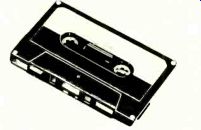
1965
Bill Lear introduces 8 -track car cartridge.
Ray Dolby demonstrates noise-reduction unit for Decca Records in London.
1966
Norelco introduces stereo cassette decks for home use. Ampex produces commercially recorded stereo cassettes.
1968
DuPont demonstrates chromium dioxide tape for video use in May. Kenwood becomes first Japanese manufacturer to make impact on U.S. high fidelity component market.
1969
American viewers watch landing of man on the moon live and in color in July.
1970
Advent offers blank chromium dioxide cassettes in July.
1971
Electro-Voice introduces matrixed 4 -channel disc process in Feb. Congress passes "antipiracy" bill, giving recordings 75-year copyright, in Feb. Columbia unveils SQ in Apr.
1972
Sansui introduces QS matrixed disc Feb. 1. On May 1, RCA releases first two Quadradiscs, Hugo Montenegro's "Love Theme from The Godfather" and "The Fantastic Philadelphians, Vol. 1." 1974
FTC sets standard for measuring power output of home entertainment products, requires specification of distortion and bandwidth.
1975
Teldec markets color Videodisc system in Germany. Sony introduces Betamax home color video cassette system in Nov.
1976
Philips and RCA demonstrate rival color video disc systems. On Oct. 19 President Ford signs first new copyright act since 1909.
-------------
(High Fidelity, Jan. 1977)
Also see:
The Parallel Careers of Edison and Bell; James A. Drake; Geniuses in sometime contact--and conflict
Toscanini Meets the Philadelphians